After the big deception with the elimination in the last World Cup by Belgium, the manager of Brazil, Tite, has been improving the squad and testing new tactics to bring balance to his team.
In this tactical analysis, we’ll see how Tite has implemented a new formation to be productive with the use of the international players that are used to the same pitch movements in their clubs. We’ll take a look at how Neymar, Ligue 1 player, and Real Madrid’s Casemiro are the key players to the new strategy that brings more solutions both defensive and offensive.
The issue
If we want to understand what Brazil’s manager is trying to do for the restart of the National team’s matches, we need to go back a couple of years. Precisely to the 2018 World Cup Round of 8 where Brazil was defeated 2-1 by Belgium.
Back then, Tite positioned Brazil’s players when attacking in a 4-1-4-1 formation and when defending a classical 4-4-2. Fernandinho and Paulinho were the midfielders responsible for protecting the defence while Coutinho was fluctuating in the middle. Neymar and William were the wingers and Gabriel Jesus the centre-forward.
Marcelo, the left-back was always advanced up the pitch while the right-back Fagner was playing more below the midline. That positioning creates depth in the left side when attacking, but the space behind Marcelo’s back was attractive to Belgium’s team.
Usually, the defender Miranda had to cover the left-back opening space in the middle. See the image below. The counter-attack from Belgica is always aiming a quick pass to the wide left or right side. Romero Lukaku moves to attract the Brazilian defender and open space to Kevin De Bruyne and Marouane Fellaini to reach clear rooms in front of the penalty area.
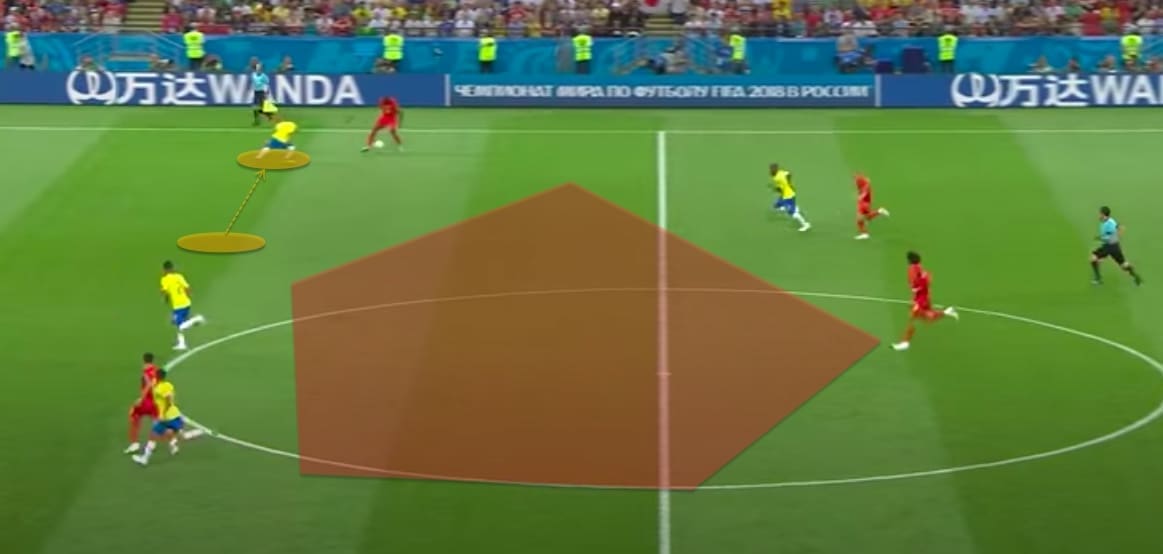
Tite chose Fernandinho to be defensive midfielder due to his quality with positioning and passing. The player struggled to follow Belgium’s offensive transition and had no help to cover for Marcelo and Paulinho when both were advanced.
The image below we can see De Bruyne receiving the ball in the free space on the midfield while Miranda was covering the left-back. Fernandinho was on the right side when Brazil lost the ball, and he could only follow Eden Hazard from behind. There was no one to cover the middle.
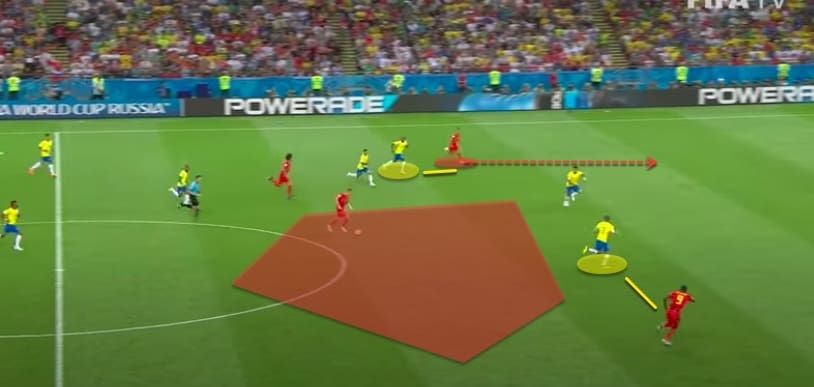
Belgium won that match with an own goal from Fernandinho and a perfect shot from De Bruyne from outside the box. Brazil tried everything to tie the match, but Belgium’s goalkeeper Thibaut Courtois made sure it didn’t happen.
But the difficulties and how Belgium took advantage of Brazil’s defensive issues made Tite wonder how he could improve the team’s balance. Being able to attack the sides with fluctuation in the middle but presenting a better defensive transition.
Changing players, beginning to fix the issue
Last year Tite started to make a few renews in its international players to improve the tactics. In a friendly but competitive match against Argentina, Danilo and Alex Sandro were right and left-backs. Casemiro took the centre-midfield position and Arthur, and Lucas Paquetá appeared in the middle. Without Neymar, William, Gabriel Jesus and Roberto Firmino was the attacking trio.
With those players, Tite could present a better stable defensive system. Danilo and Alex Sandro are more defensive players and facing Lionel Messi as the opponent; the four defensive line was formed almost the entire match. The frame below shows Danilo, Eder Militão, Thiago Silva and Alex Sandro well-positioned to prevent surprises in the counter-attack.
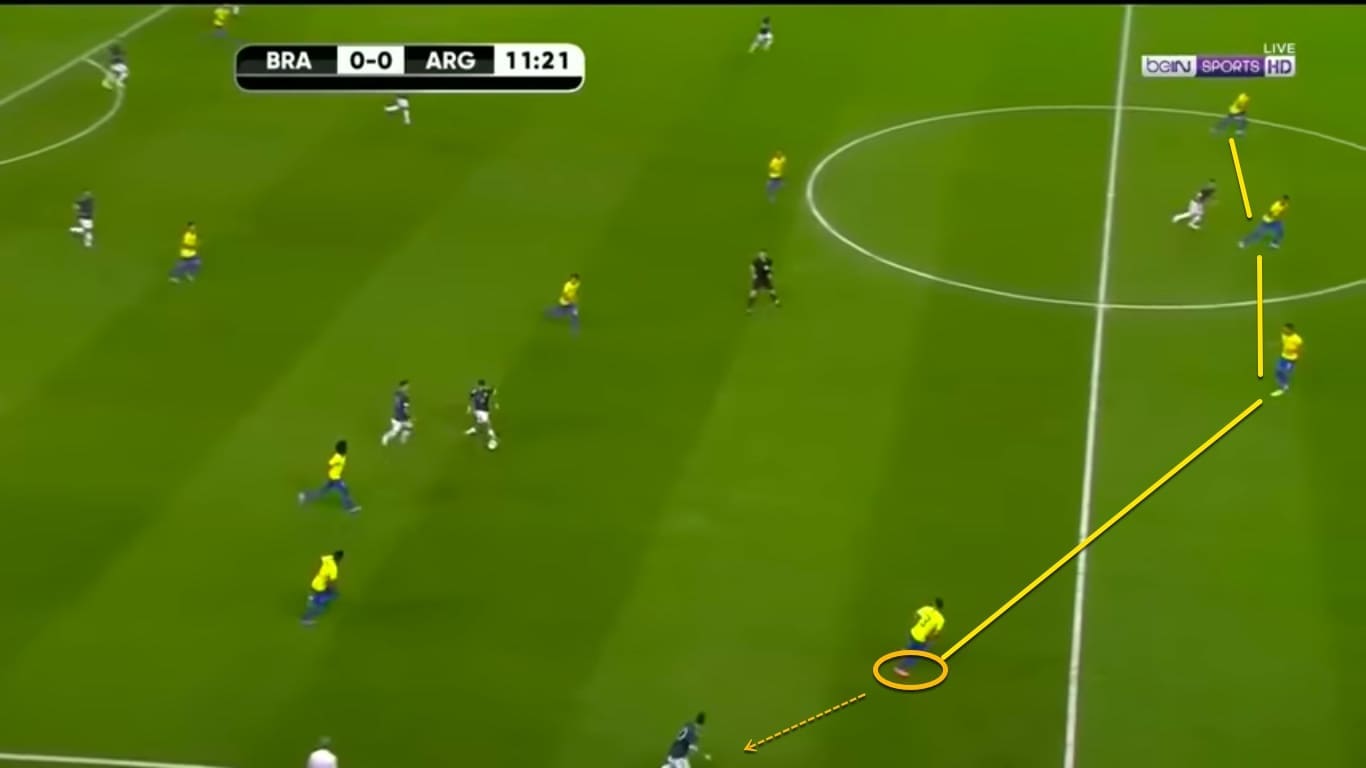
Casemiro has an essential role in Brazil’s defensive system. Replacing Fernandinho, he can deliver the same passing quality in the construction phase while much higher standards in defensive transitions.
Let’s get back to the 2019 Copa America Final. Brazil faced Peru in Maracanã with Casemiro being the defensive midfielder with Arthur on his side and Coutinho fluctuating in the middle. The Real Madrid’s player was already covering the counter-attacks like Fernandinho, but neither Alex Sandro and Dani Alves wasn’t so advanced as Marcelo was in the World Cup match.
The image below shows Dani Alves making a wrong pass in the middle losing the ball. Peru tried the counter-attack, but Jesus is speedy and quickly closes the right side while Casemiro closes the middle.
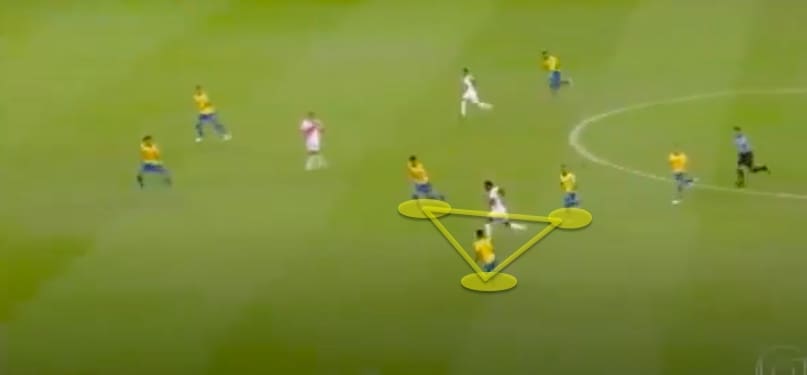
The frame above also shows Brazilian defenders in line while Alex Sandro runs back to cover the left-side without breaches.
A year passed the elimination to Belgium and Tite had already a player to be a reference in the defensive transition with the capacity to cover the middle with intensity. The question remained how to solve the balance between defending and attacking. With a well-formed line of four in the defence, Casemiro could be a protector in the middle. But how to attack the sides efficiently with that system?
Offensive transition
With Casemiro fixed in the middle, Tite needed to find how to attack the opponent’s side without leaving the midfielder unsupported. He already gave a few clues in the friendly match against Argentina in November last year. We saw for a few moments in that match Danilo conducting the ball and beginning the offensive transition through the inside of the pitch rather than the right side.
The image below shows Danilo bringing the ball to the middle while Jesus was playing as the winger on the right. Arthur approached to be option pass, and Casemiro fixed in the middle protecting the defence.
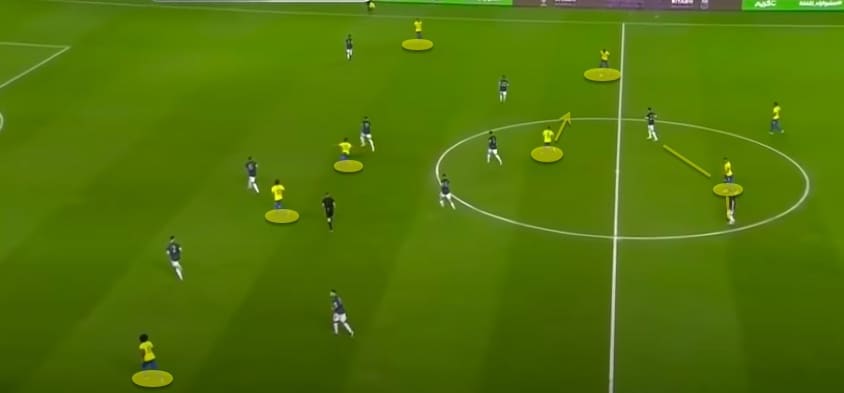
We can see that William was giving depth on the left side while Coutinho fluctuates in the centre-attack with Firmino. We don’t see in the frame Alex Sandro who is in the middle left side, not giving any option to the offensive transition.
Perhaps this was one of the reasons he lost opportunities in the National team. With Casemiro protecting the defence and having Danilo acting defensively on the right, Renan Lodi could be a better option. The Atletico Madrid’s player has been consistent in the defence and a good offensive creator in his club.
Adjusting positions
Tite brought a new player to the first round of the Conmebol’s WC Qualifying: Douglas Luis. The Aston Villa’s midfielder fitted on the pitch quite perfectly to be the solution that Tite was looking for.
The younger Brazilian player was positioned as the third player in a three-line midfield formation. Casemiro being the centre-midfielder, Danillo on the right and Douglas Luis giving support and closing the spaces on the left side.
Danilo already played like this with Pep Guardiola in his Manchester City times. In a 2-3-5 offensive formation, Danilo acted on the right side of the three-line to be supportive in the offensive transition. He has good passing, good viewing and is vigorous to be combative when the team loses the ball. Douglas Luis also has good passing, viewing and can be effective in covering the defence on the left side.
The scheme below shows how the original position players and how they will fill the pitch in the offensive phase.
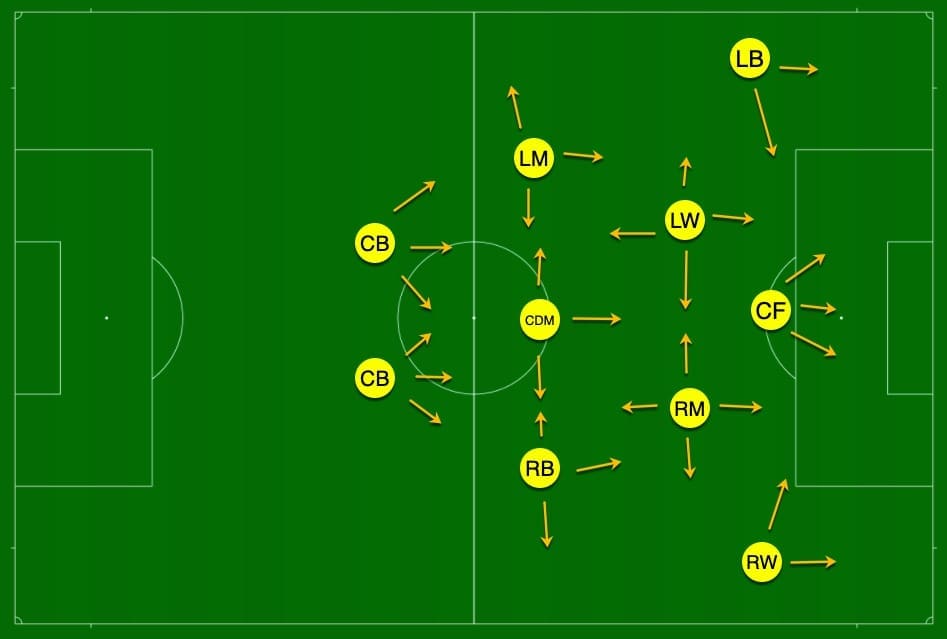
Since Neymar, originally a left-winger, evolved to play a more dynamic function in the attacking phase, Tite needs to keep depth on the left side and use the left-back is a good option. Renan Lodi and Alex Telles were the choices against Bolivia and Peru.
Looking at the image below, in the match against Peru, we can see how Neymar executes a midfield/attacking action in the middle while Lodi is wide open in the left-wing. Coutinho also fluctuates in the middle and Danilo, Casemiro and Douglas Luis are near as pass options while also protecting the defence.
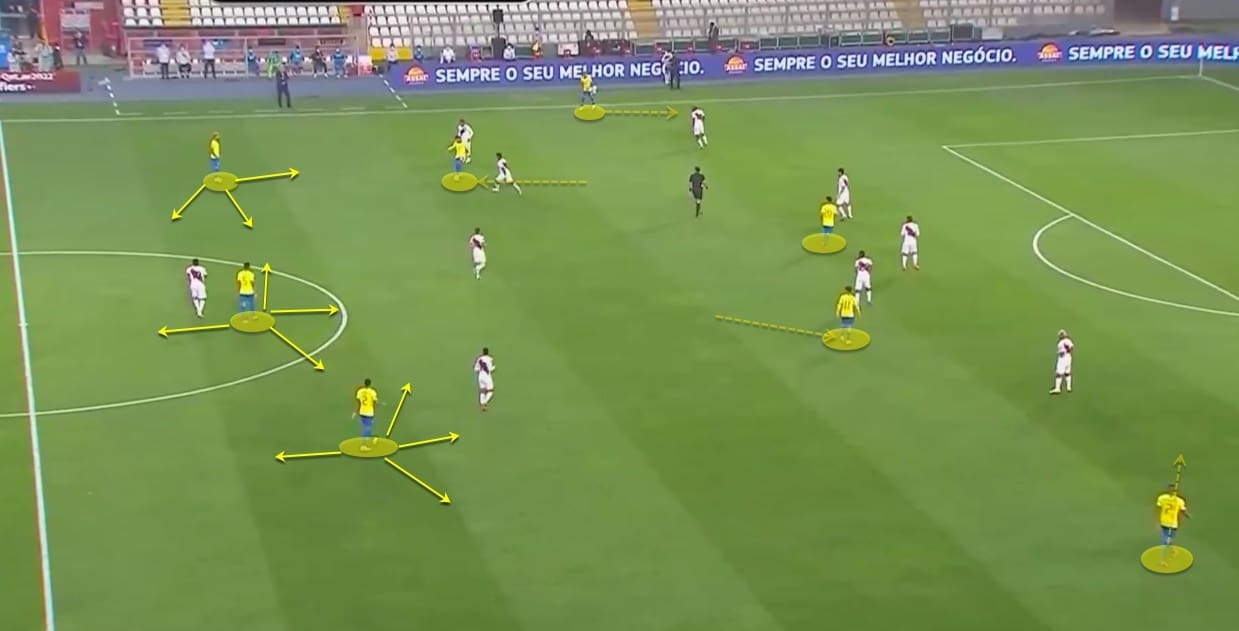
When attacking, the three midfielders positioned can approach for triangulations and be options to keep the ball possession. With Danilo being a right-back in the middle, he can also be an option to advance in the space created by the right-winger movements.
The image below we can see Neymar is dribbling the ball in the middle. Richarlison centralized and opened a corridor on the right side where Danilo can move. Casemiro and Douglas are options and also protecting the counter-attack.
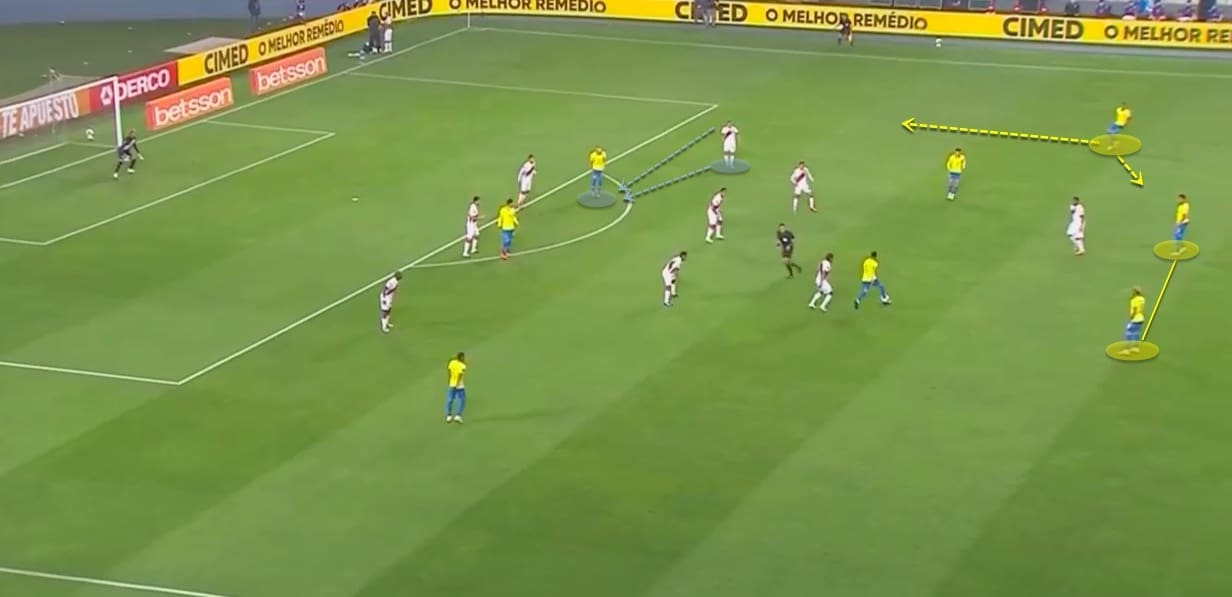
Keeping this 2-3-2-3 formation in the offensive transition gives Tite a few alternatives to build the attack. Lodi on the left is an excellent choice for balls crossing through the area. Roberto Firmino, Neymar and Coutinho fluctuating in the front of the penalty area can triangulate to quickly conclude on goal. And on the left side, Tite opted for a winger that is strong on the 1vs1 confrontation. Everton Soares was tested first and then Richarlison.
Brazil has a lot of international players to provide Tite with a variety of movements in the same formation. Both offensive and defensive. Every position has a player replacement with characteristics that can provide for the same action the starter squad does.
Playing in the middle left along with Casemiro there’s Arthur from Juventus and Bruno Guimarães from Lyon. To be on the right side replacing Danilo there is Fabinho from Liverpool, Everton Menino from Palmeiras and Guga, Atletico Mineiro’s player that have been playing as a third midfielder with the manager Jorge Sampaoli.
If the depth is needed in the right side, besides Everton and Richarlison, Rodrygo, Vini Jr, Gabriel Jesus, David Neres and Anthony, from Ajax, are suitable options. The importance of Tite found the way to fix the covering on the defensive transition is the options to create attacking movements to surprise the opponent.
Conclusion
Tite can use the matches of the WC qualifying to improve the new tactical movements. Practising to be more accurate in the balance of his team. It would be hard to see Brazil struggling in the qualifiers due to the tournament disparity. Brazil’s manager has a great opportunity to test and train the tactics aiming a better strategy for the next World Cup.
What we saw in this tactical analysis is that the international players are fitter to the new system. Tite has a variety of players to use in the strategy of fluctuating in the middle. Attacking the sides and protecting the defence not to be exposed as it was in the last World Cup.
Calling Arthur, Juventus player, Vini Jr. and Gabriel Jesus to the next round of the qualifying show that Tite is already thinking in alternative players to execute the same tactical movements. Keeping the pattern and the intensity we have a potential showcase of success for the 2022 World Cup.

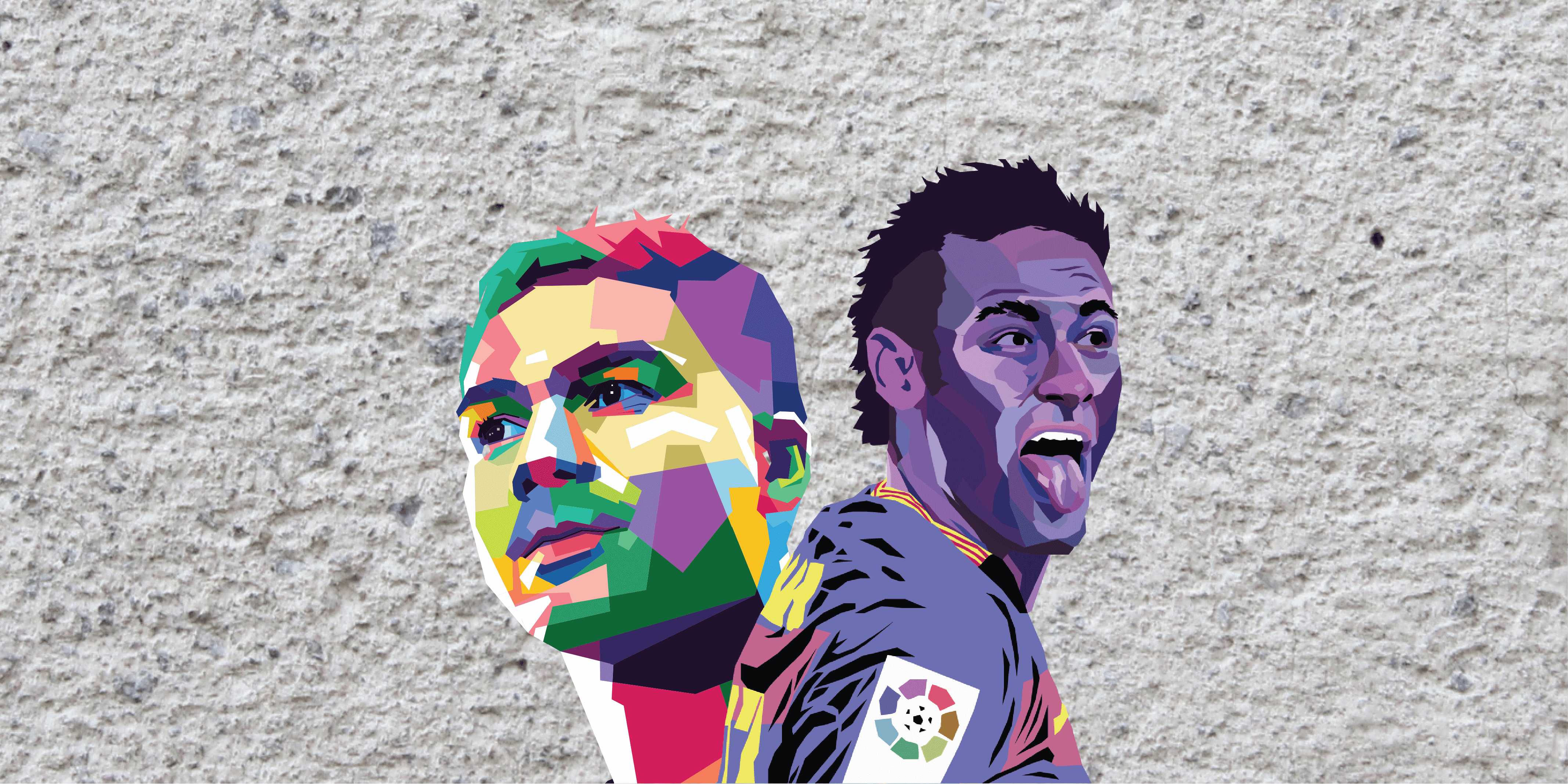



Comments